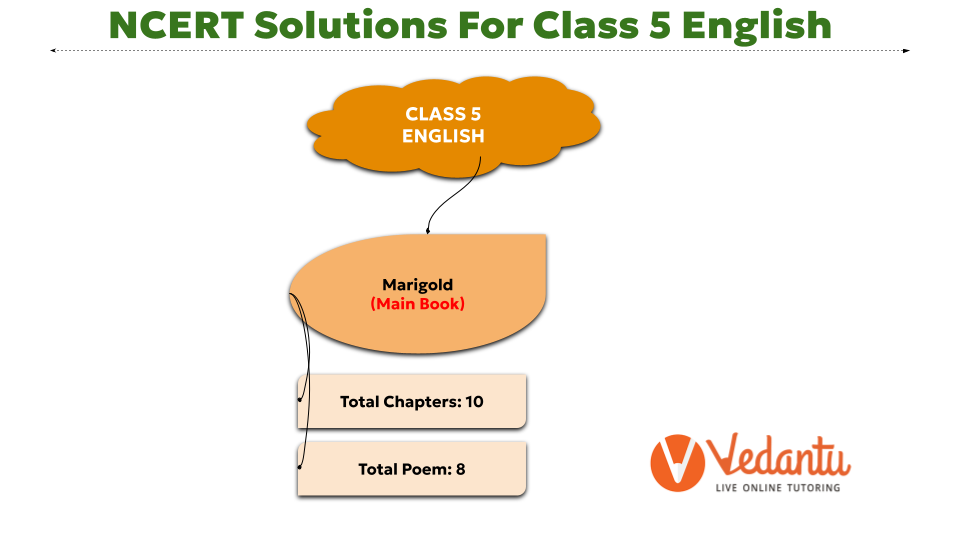Chapter-wise Class 5 English Questions and Answers Free PDF Download
FAQs on NCERT Solutions For Class 5 English All Chapters - 2025-26
1. How do NCERT Solutions for Class 5 English help in writing better answers for homework and exams?
Vedantu's NCERT Solutions provide a clear, step-by-step framework for answering questions exactly as per the CBSE guidelines for the 2025-26 session. They demonstrate how to structure an answer, use appropriate vocabulary from the text, and include key points from the chapter. This helps students develop strong answer-writing skills for both homework and final exams, rather than just guessing the correct format.
2. Do the NCERT Solutions for Class 5 English also cover grammar exercises from the 'Marigold' textbook?
Yes, the NCERT Solutions provide detailed answers for all exercises in the 'Marigold' textbook, including the integrated grammar sections. This covers topics like tenses, punctuation, word building, and sentence formation that are part of each chapter, ensuring comprehensive preparation in both literature and language skills.
3. How many textbooks are prescribed for CBSE Class 5 English in the 2025-26 session?
For the 2025-26 academic session, the CBSE curriculum for Class 5 English prescribes one primary textbook, which is NCERT's 'Marigold'. This book contains all the prose and poetry chapters for the year. Our NCERT Solutions cover every question and exercise from this official textbook, ensuring complete syllabus alignment.
4. What are the main chapters covered in the NCERT Solutions for the Class 5 English textbook?
The NCERT Solutions cover all 10 units of the 'Marigold' textbook. Key prose and poetry chapters for which solutions are provided include:
Ice-cream Man and Wonderful Waste!
Teamwork and Flying Together
My Shadow and Robinson Crusoe
Crying and My Elder Brother
The Lazy Frog and Rip Van Winkle
...and all other chapters such as Gulliver’s Travels and The Talkative Barber.
5. Why is it important to understand the method in the NCERT Solutions instead of just memorising the answers?
Memorising answers is only useful for specific questions. Understanding the step-by-step method in the solutions teaches you the logic behind an answer. This approach builds critical thinking and problem-solving skills, which is crucial for tackling unfamiliar or higher-order thinking skill (HOTS) questions in exams, as you have learned the correct process to construct a new answer.
6. How can I use the NCERT Solutions to understand the central theme in poems like 'My Shadow' or stories like 'The Talkative Barber'?
The solutions do more than provide direct answers. For questions about themes, the answers are written to highlight the key ideas and character motivations. By studying how the solution explains a character's actions in 'The Talkative Barber' or the poet's imagination in 'My Shadow', you learn to identify and articulate the deeper meaning in any text, a key skill for literary analysis.
7. Beyond just answering questions, how do these solutions help improve vocabulary and sentence construction?
The NCERT Solutions are crafted by subject experts using clear and precise language as expected by the CBSE. By regularly studying them, you are exposed to richer vocabulary and correct sentence structures. The answers model how to frame thoughts effectively, helping you improve your own writing style and making your answers more expressive and grammatically accurate.
8. What should I do if a question in the Class 5 English textbook seems difficult even after checking the NCERT Solution?
If a solution seems complex, it is a great learning opportunity. First, re-read the relevant part of the chapter to refresh the context. Then, try to break the solution down into smaller parts to see how it connects to the question. This helps you build analytical skills. The goal is to use the solution as a guide to develop your own understanding, not as a final answer to be copied.
9. Are the Vedantu NCERT Solutions for Class 5 English aligned with the latest 2025-26 CBSE syllabus?
Absolutely. All our NCERT Solutions for Class 5 English are meticulously prepared and reviewed by subject matter experts to be fully compliant with the latest 2025-26 CBSE curriculum and NCERT guidelines. We ensure that any changes in the syllabus or question patterns are reflected in our solutions, providing students with the most accurate and relevant study material.

























